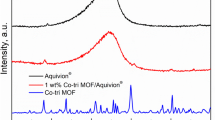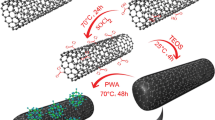Abstract
Metal-organic frameworks can be intentionally coordinated to achieve improved proton conductivity because they have highly ordered structures and modular nature that serve as a scaffold to anchor acidic groups and develop efficient proton transfer pathways for fuel cell application. Using the concept of a coordination network, the conductivity of Nafion® was tuned by the incorporation of HKUST-1. It has CuII–paddle wheel type nodes and 1,3,5-benzenetricarboxylate struts, feature accessible sites that provides an improved protonic channel depending on the water content. In spite of the fact that HKUST-1 is neutral, coordinated water molecules are contributed adequately acidic by CuII to supply protons to enhance proton conductivity. Water molecules play a vital part in transfer of proton as conducting media and serve as triggers to change proton conductivity through reforming hydrogen bonding networks by water adsorption/desorption process. Increased ion exchange capacity and proton conductivity with lower water uptake of the H3PO4-doped material, and improved thermal stability (as confirmed by thermogravimetric analysis) were achieved. The structure of HKUST-1 was confirmed via field emission scanning electron microscopy and X-ray diffraction, while the porosity and adsorption desorption capacity were characterized by porosity analysis.
Graphical abstract

The H3PO4-doped HKUST-1/Nafion® composite membrane is demonstrated to be a promising material based on its proton conductivity. HKUST-1 has an average particle diameter of around 15–20 µm. The proton conductivity, IEC values, and the thermal stability of the 2.5 wt% HKUST-1/Nafion® composite membrane suggest that HKUST-1 may be a promising candidate as a proton-conductive material in the polymer electrolyte fuel cell membrane due to its reasonable proton passageway, favorable surface area, lower water uptake with the higher IEC, and proton conductivity of the H3PO4-doped material and facile synthesis.






Similar content being viewed by others
References
Ahmed I, Hasan Z, Khan NA, Jhung SH (2013) Adsorptive denitrogenation of model fuels with porous metal-organic frameworks (MOFs): effect of acidity and basicity of MOFs. Appl Catal B Environ 129:123
Bose S, Kuila T, Nguyen TXH, Kim N-H, Lau KT, Lee J-H (2011) Polymer membranes for high temperature proton exchange membrane fuel cell: recent advances and challenges. Prog Polym Sci 36:813
Chui SSY, Lo SMF, Charmant JPH, Orpen AG, Williams ID (1999) A chemically functionalizable nanoporous material [Cu3 (TMA)2 (H2O)3] n. Science 283:1148
Goswami S, Adhikary A, Jena HS, Biswas S, Konar S (2013) A 3D Iron (II)-based MOF with squashed cuboctahedral nanoscopic cages showing spin-canted long-range antiferromagnetic ordering. Inorg Chem 52:12064
Horike S, Umeyama D, Kitagawa S, Kim K (2013) Ion conductivity and transport by porous coordination polymers and metal-organic frameworks. Acc Chem Res 46(11):2376
Jeong NC, Samantha B, Lee CY, Farha OK, Hupp JT (2012) Coordination-chemistry control of proton conductivity in the iconic metal-organic framework material HKUST-1. J Am Chem Soc 134:51
Kuan H-C, Wu C-S, Chen C-Y, Yu Z-Z, Dasari A, Mai Y-W (2006) Preparation of exfoliated zirconium phosphate/Nafion organic-inorganic hybrid proton exchange membranes. Electrochem Solid-State Lett 9(2):76
Kumar R, Xu C, Scott K (2012) Macro-/microporous MOF composite beads. RSC Adv 2:8777
Laura D, Neil O, Zhang H, Bradshaw (2010) J. Mater. Chem. 20:5720
Sadakiyo M, Yamada T, Honda K, Matsui H, Kitagawa H (2014) Control of crystalline proton-conducting pathways by water-induced transformations of hydrogen-bonding networks in a metal-organic framework. J Am Chem Soc 136:7701
Sayeed MA, Talukdar K, Kim HJ, Park Y, Gopalan AI, Kim YH, Lee KP, Choi SJ (2014) Passive approach for the improved dispersion of polyvinyl alcohol-based functionalized multi-walled carbon nanotubes/Nafion® membranes for polymer electrolyte membrane fuel cells. J Nanosci Nanotechnol 14(12):9329–9334
Talukdar K, Kim HJ, Kim YH, Lee HC, Choi SJ (2014) Polyacrylamide/Nafion® semi-interpenetrating networks as proton-conducting membrane of direct methanol fuel cell. Sci Adv Mater 6:1
Xu G, Yamada T, Otsubo K, Sakaida S, Kitagawa HJ (2012) Facile “Modular assembly” for fast construction of a highly oriented crystalline MOF nanofilm. J Am Chem Soc 134:16524
Yoon M, Suh K, Natarajan S, Kim K (2013) Proton conduction in metal-organic frameworks and related modularly built porous solids. Angew Chem Int Edit 52:2688
Zhang S, Liu H, Sun C, Liu P, Li L, Yang Z, Feng X, Huo F, Lu X (2015) CuO/Cu2O porous composites: shape and composition controllable fabrication inherited from metal organic frameworks and further application in CO oxidation. J Mater Chem A 3:5294
Acknowledgments
This work was supported by the Priority Research Centers Program through the National Research Foundation of Korea (NRF), and funded by the Ministry of Education, Science, and Technology (2009-0093819).
Author information
Authors and Affiliations
Corresponding author
Additional information
Hee Jin Kim and Krishan Talukdar have contributed equally to this work.
Rights and permissions
About this article
Cite this article
Kim, H.J., Talukdar, K. & Choi, SJ. Tuning of Nafion® by HKUST-1 as coordination network to enhance proton conductivity for fuel cell applications. J Nanopart Res 18, 47 (2016). https://doi.org/10.1007/s11051-016-3346-9
Received:
Accepted:
Published:
DOI: https://doi.org/10.1007/s11051-016-3346-9




